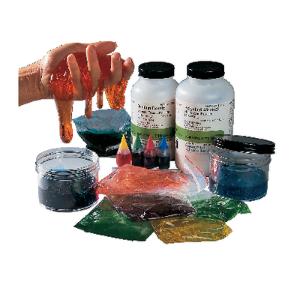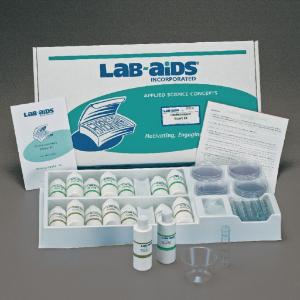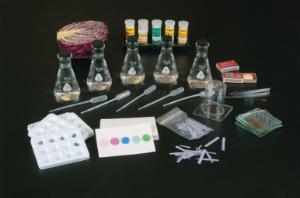Set the Kitchen Table for Science Time
All grades
The fun part about science is that whether it's in laboratories, at school, or in your house―science happens everywhere.
There's a treasure trove of science experiments hiding in our refrigerators, pantries, and junk drawers. Whether they're making their own rock candy, cloud in a jar, "indestructible" bubbles, or performing magic (science!) tricks, this roundup has something for even the most curious minds in your classroom. These activities are brimming with creative inspiration and can be done with items commonly found around the house. This roundup covers experiments in physics, chemistry, biology, and more; it has everything but the kitchen Zinc!
Safety first! Whenever you're doing any science experiment, whether in the classroom or at home, be sure to practice proper lab safety precautions, including wearing eye protection, getting adult supervision, and never eating or drinking your science experiments!
Scoop up a heaping helping of these experiments:
- Don't burst our bubbles – Owlcation: Bubble Science Experiments
The secret to making bubbles is surface tension. Adding dish soap to water changes the water's surface tension, which becomes a great bubble-making solution. Students learn how replacing water with glycerin or corn syrup changes the surface tension and create super bubbles.
- Catch a cloud – Little Bins for Little Hands: Cloud in a jar
Weather activities like this cloud in a jar can be so fun and simple and spark curiosity in your students. So, get your head IN the clouds and add it to your weather science lesson plans to help your students learn all about how clouds are formed.
- Opposites attract – Brusspup: 9 Awesome experiments using static electricity
They say opposites attract, and that couldn't be truer with these fun static electricity experiments. Find out about positively and negatively charged particles using a few basic items. Can you control whether they will be attracted or unattracted to each other? Most of these cool activities require a small piece of PVC piping.
- Three simple solar science snacks – The Educators Spin On It: Solar Science Experiments for Kids
Simple and fun activities to teach students about renewable energy sources. These experiments are geared for children ages 5-10 but may be adapted for all ages.
If your students aren't yet familiar with the greenhouse effect, don't sweat it, we've got you covered. In this simple activity, students can use common household supplies to simulate the greenhouse effect.
Rocket tonight! Ward's World: Rock it at home with this rocket activity.
This rocket ship activity will excite your students while teaching basic scientific principles related to chemical reactions, gravity, rockets, thrust, pressurization, and carbon dioxide.
- Get your fizz on with carbonated chemical reactions – ACS Chemistry for Life: Diet Coke and Mentos
There's a lot of cool chemistry in a can of pop! Learn how solubility, chemical equilibrium, acids & bases, and gas laws work in some of your favorite bubbly drinks. Try these classic experiments with Diet Coke and Mentos.
- Rock candy, a delicious crystal creation – Exploratorium: Cooking Candy
When your students make rock candy, they can see the shape of sugar crystals on a giant scale. As the water evaporates, sugar crystals form on the string or stick, and the shapes that they form reflect the shape of individual sugar crystals.
- Marvelous microbiology – The Kitchen Pantry Scientists: Homemade Petri Plates and Microbe Zoos
Growing and testing bacteria is a fun activity for the mad scientists in your classroom. Bacteria are everywhere, and since they reproduce rapidly, they are easy to study with just a few simple materials.
Make your own sourdough bread starter – SciStarter: Sourdough for science
In this activity, students can create their own sourdough starter from scratch, just by mixing flour and water. Over the course of 14 days, they can take a series of simple measurements to track the growth of their own "microbial garden."
- Shocking science – Education.com: Homemade Electroscope
Static electricity can be caused by bringing two materials together or separating them. The shock released when the charged surface touches something else is caused by electrons leaping across to the surface without a charge. Get this activity so students can learn how to build a homemade electroscope to see this in action!
- Humpty dumpty – Imagination Station: How to Make a Naked Egg
This experiment shows what happens to an egg when put in vinegar. It shows the acetic acid in vinegar dissolving the shell of an egg by eating away the calcium carbonate; it releases carbon dioxide gas and leaving calcium acetate, which is soluble. This experiment is easy and cool to do; you just need three simple household items. You can also watch this cool video of the experiment by Bryson.
- Let it glow, let it glow, let it glow – Red Tricycle: 6 Glow in the Dark Experiments to try Tonight
Calling all mad scientists! Try these six glow-in-the-dark experiments after the sun goes down: we promise they will light up your night. Click through the slideshow to get the details.
- Salad solution – Science Friday: Salad Dressing Science: Emulsion Lab
If you've ever tried to make salad dressing from scratch, you know that one of the biggest challenges is getting the oil and the vinegar to mix properly. No matter how hard you try to shake, stir, or whisk oil and vinegar together, they eventually separate. In this experiment, you will test a few common household ingredients to see which is the most effective emulsifier for making salad dressing—and you can eat your results!
- When life gives you lemons – Education.com: Lemonade Science
Quench your thirst with great tasting lemonade while you explore the concepts of acid and base, and how these differ from sweet and sour. Materials are readily available, except for the pH paper, which can be purchased here, OR keep reading the next activity to learn how to make your own at home using red cabbage!
It's easy, safe, and fun to make your own pH paper test strips then test them on soda, vinegar, and other household items.
- Make a potato battery – Love to Know: How to Make a Potato Battery
This cool activity lets you turn a potato into a battery. The potato battery is a great activity to discuss the transfer of energy, from chemical to electrical energy.
- Propagate vegetables and plants in water – Seeds Now: 10 Vegetables You can Re-grow in Water
Many plants can grow new roots and a whole new plant from just a piece of stem (i.e., a potato) or a piece of root (i.e., a sweet potato). You can also use any number of other plants growing outside – make it an exploration to figure out which ones can and cannot do it. You don't even need to use rooting hormones; just plain tap water is often enough for many plants. This illustrates the amazing modular nature of plants vs. animals, and meristematic tissues, the plant equivalent of human stem cells.
- Study the effects of ethylene on fruit ripening – NBC Learn: Ethylene Gas Investigation
Students will design and conduct an experiment that allows them to observe the ripening of tomatoes under different conditions. Students will be able to evaluate the effectiveness of various strategies for ripening tomatoes. Students will discuss the role of ethylene gas in this process.
Plastic wrap is supposed to keep food fresh in the fridge. If you have fruit you would like to save, then you'll probably want it to stay moist instead of dehydrating or drying out. Does plastic wrap actually prevent this process and keep food moist? In this experiment, students will test different kinds of plastic wrap and see which, if any, holds in moisture.
Use these awesome experiments to bring the excitement of scientific investigation to your students right in their own kitchens. You can also check out this post to see other resources we've pulled together to support your distance learning needs.
Recommended Products:
[StartProductBlock]

Slime Kit & Polymer Lab
With this lab, your students can become chemists and make their own polymer — slime. In addition, students can follow the activities in the lab to investigate the many forms and uses of man-made polymers.
[EndProductBlock]
[StartProductBlock]
Easy Extraction of Essential Oils Kit
With this easy-to-use kit, students extract the essential oils from fragrant substances (like a coffee bean or lemon) by dissolving the plant oils in fat, then separating them by condensation.
[EndProductBlock]
[StartProductBlock]

Chemiluminescence Student Activity
In this Lab-Aids® kit, students conduct a series of activities that produce light energy using luminol and an activator solution to create blue light. Students are introduced to an oxidation-reduction reaction as well as rates of reaction, ratios of chemicals used in the reaction, and effects of temperature on chemiluminescence.
[EndProductBlock]
[StartProductBlock]

Coleslaw Chemistry Kit
Students make indicator solution and pH strips out of red cabbage juice and then use the strips to create their own pH reference chart. Students test the acidity of "rain" in a controlled atmosphere.
[EndProductBlock]
